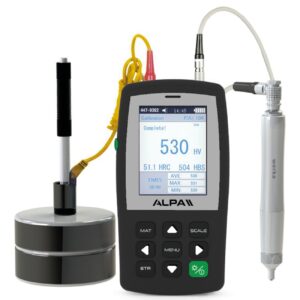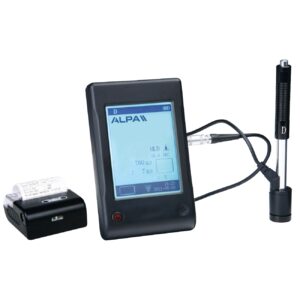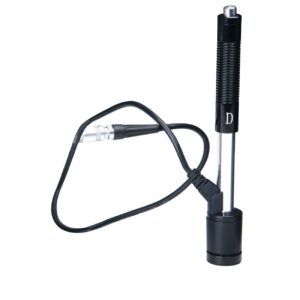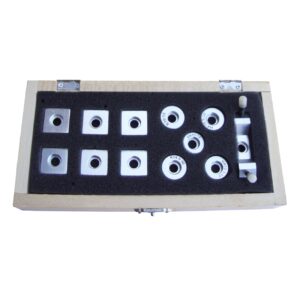Digital and analogue hardness testers are essential tools in the mechanical workshop and manufacturing industries. These devices are designed to measure the hardness of a material, a crucial parameter that determines a material's resistance to permanent deformation. Hardness is a fundamental property that affects the machinability, wear resistance and durability of a component. In this in-depth look, we explore the characteristics, applications and benefits of digital and analogue hardness testers, providing a comprehensive guide to their selection and use.
Understanding hardness testers: a technical overview
Hardness testers are measuring instruments that assess the hardness of a material by applying a force to a surface. There are several hardness scales, including Rockwell, Brinell and Vickers, each of which is suitable for specific types of materials and applications. Digital and analogue hardness testers differ mainly in the way they display measurement results.
Analogue hardness testers use a mechanical dial to indicate hardness, while digital hardness testers provide an electronic readout on a display. Digital models often offer advanced features such as data storage, the ability to transfer results to a computer and automatic calibration, making them ideal for applications requiring accuracy and traceability.
Applications of hardness testers in machine shops
In machine shops, hardness testers are used to ensure that materials and components meet the required hardness specifications. This is especially important in the production of wear parts such as gears, bearings and cutting tools. Hardness measurement makes it possible to predict the service life of a component and to optimise machining processes.
Digital hardness testers are particularly appreciated for their ease of use and ability to provide fast and accurate results. The ability to store and analyse measurement data allows operators to monitor changes in hardness over time, identifying potential quality problems before they become critical.
Advantages of digital versus analogue hardness testers
Although both types of hardness testers have their merits, digital models offer several significant advantages. The accuracy and reliability of digital readings reduce the risk of human error, while data logging capabilities facilitate documentation and analysis of measurements. In addition, digital hardness testers often include automatic calibration options, which ensure that the instrument is always ready for use with maximum accuracy.
On the other hand, analogue hardness testers are generally cheaper and do not require a power supply, making them ideal for applications where simplicity and robustness are priorities. However, reading the results requires manual interpretation, which can introduce variability into the collected data.
How to choose the right hardness tester for your needs
Choosing the right hardness tester depends on several factors, including the type of material to be tested, the hardness scale required and the operating conditions. For metallic materials, the Rockwell and Brinell scales are commonly used, while for softer materials such as plastics, the Shore scale is more appropriate.
It is also important to consider the working environment. If measurements have to be taken under difficult conditions or in confined spaces, a portable hardness tester might be the best choice. In addition, for applications requiring a high testing frequency, a digital model with data storage capability can significantly improve operational efficiency.
Frequently asked questions about hardness testers
1. What is the difference between the Rockwell, Brinell and Vickers hardness scales?
- The Rockwell scale measures the depth of penetration of an indenter under a main load, while the Brinell scale uses a steel ball to measure the diameter of the indentation left on a material. The Vickers scale, on the other hand, uses a pyramid-shaped indenter to measure the area of the indentation.
2. Do digital hardness testers require maintenance?
- Yes, digital hardness testers require regular maintenance to ensure measurement accuracy. This includes periodic calibration and checking the condition of the indenter.
3. Can a hardness tester be used to test non-metallic materials?
- Yes, there are hardness testers specifically for non-metallic materials, such as plastics and rubbers, that use the Shore scale to measure hardness.
4. What are the limitations of analogue hardness testers?
- Analogue hardness testers can be less accurate than digital models and require manual interpretation of readings, which can introduce errors.
5. How do I calibrate a hardness tester?
- Calibration of a hardness tester varies depending on the model, but generally includes the use of standard hardness blocks to check and adjust the accuracy of the instrument.
Conclusion: the importance of hardness testers in industry
Digital and analogue hardness testers are indispensable tools for ensuring the quality and conformity of materials in machine shops and manufacturing industries. The choice between a digital or analogue model depends on specific operational requirements, but both offer significant advantages in terms of quality control and optimisation of production processes. Investing in a high-quality hardness tester can improve measurement accuracy and contribute to the long-term success of industrial operations.
Showing all 15 results







